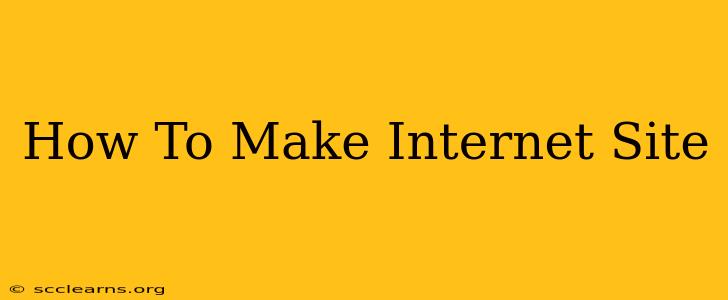So, you want to learn how to make a website? Fantastic! Whether you're starting a blog, launching an online business, or simply want a place to share your passion projects, creating a website is more accessible than ever. This comprehensive guide will walk you through the process, step by step, even if you're a complete beginner.
Choosing the Right Platform: Finding Your Website's Foundation
The first crucial step is selecting the right platform. This dictates how easy or difficult the rest of the process will be. There are three main options:
1. Website Builders (e.g., Wix, Squarespace, Weebly):
- Pros: Extremely user-friendly, drag-and-drop interfaces, minimal coding knowledge required, often include hosting. Perfect for beginners.
- Cons: Less customization, potentially higher long-term costs, limited control over features.
2. Content Management Systems (CMS) (e.g., WordPress):
- Pros: Highly customizable, vast library of themes and plugins, robust features, large community support. A great choice for scalability and flexibility.
- Cons: Requires more technical knowledge (or willingness to learn), involves choosing a separate hosting provider.
3. Coding from Scratch (HTML, CSS, JavaScript):
- Pros: Complete control over every aspect of the website, unparalleled customization.
- Cons: Requires significant coding skills, time-consuming, steep learning curve. Not recommended for beginners.
For most beginners, a website builder or WordPress is the recommended starting point. WordPress offers a balance of ease of use and customization.
Step-by-Step Guide to Building a Website with WordPress (Recommended)
This section assumes you've chosen WordPress.
1. Secure Web Hosting: Your Website's Home
You'll need a web hosting provider – a company that stores your website's files and makes them accessible online. Popular options include Bluehost, SiteGround, and HostGator. Choose a plan that fits your needs and budget. Consider factors like storage space, bandwidth, and customer support.
2. Install WordPress: Getting Started
Most hosting providers offer one-click WordPress installation. This simplifies the process significantly. Follow your hosting provider's instructions to install WordPress.
3. Choosing a Theme: Your Website's Look and Feel
Themes control the visual design of your website. WordPress offers thousands of free and premium themes. Select a theme that aligns with your brand and content. Consider factors like responsiveness (how well it adapts to different devices) and ease of customization.
4. Installing Essential Plugins: Enhancing Functionality
Plugins extend WordPress's functionality. Essential plugins include:
- Yoast SEO: Optimizes your website for search engines.
- Contact Form 7: Creates contact forms for visitors.
- UpdraftPlus: Backs up your website regularly (crucial for data protection).
5. Creating Pages and Content: Bringing Your Vision to Life
Now it's time to create the pages for your website (e.g., About Us, Contact, Services). Write compelling, high-quality content that engages your visitors. Use relevant keywords to improve your search engine ranking.
6. Optimizing for Search Engines (SEO): Getting Found
Search engine optimization (SEO) is crucial for getting your website discovered online. This includes:
- Keyword Research: Identifying relevant keywords your audience uses.
- On-Page Optimization: Optimizing your website's content and code for search engines.
- Off-Page Optimization: Building backlinks to your website from other reputable sources.
Maintaining Your Website: The Ongoing Process
Building a website is just the first step. Regular maintenance is key:
- Regular Backups: Prevent data loss.
- Software Updates: Keep WordPress, themes, and plugins up-to-date for security and performance.
- Content Updates: Regularly add fresh, high-quality content to keep your audience engaged.
Creating a website can seem daunting initially, but by following these steps and choosing the right platform, you can build a successful online presence. Remember to be patient, persistent, and always learn and adapt as you grow.

